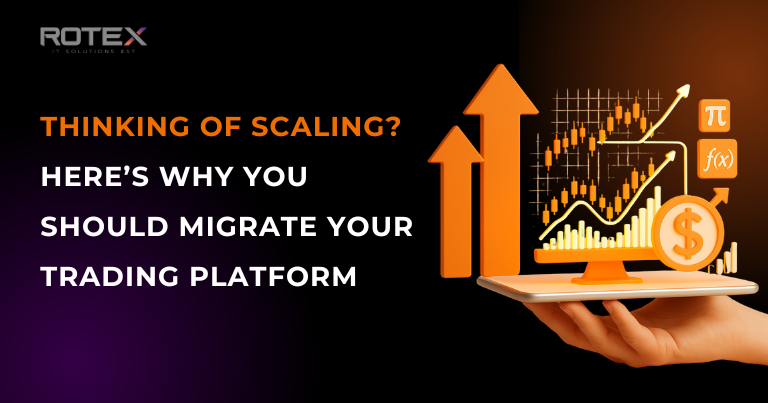Ready to Scale? Here’s Why It’s Time to Migrate Your Trading Platform
In the fast-paced, ever-evolving world of Forex trading, standing still is the fastest route to irrelevance. As technology continues to advance and client expectations rise, many brokerages find themselves limited by outdated, slow, or inflexible trading platforms. If your current platform is more of a bottleneck than a launchpad, it might be time for something bigger, faster, and smarter.
That’s where trading platform migration comes in — and it’s not just a tech upgrade. It’s a strategic move that can future-proof your brokerage, unlock new revenue streams, and significantly improve your operational agility.
In this article, we explore the what, why, and how of migrating your trading platform — and how Rotex IT Solutions can help make the transition seamless.
Why Consider a Trading Platform Migration? (H2)
Let’s start with the big question: why change something that “still works”?
The answer is simple — because “still works” isn’t good enough in today’s hyper-competitive FX landscape. If your platform limits your growth, fails to integrate with modern systems, or leads to slow client onboarding and trade execution, it’s time to move.
Signs you’ve outgrown your current trading platform: (H3)
- Traders are complaining about execution speed or interface usability
- You struggle to integrate with new CRMs, liquidity providers, or payment gateways
- New asset classes or regional regulations aren’t supported
- Reporting, analytics, or back-end controls are inefficient
- Your competitors offer more advanced tools or better user experience
Migrating to a faster, more flexible platform isn’t a cost — it’s an investment in your brokerage’s scalability and sustainability.
Key Benefits of a Trading Platform Migration (H2)
When executed correctly, platform migration can deliver substantial improvements across every function of your brokerage.
1. Improved Execution Speed & Performance (H3)
A modern platform offers ultra-low latency and optimized infrastructure — resulting in faster trade execution, reduced slippage, and a better client experience. This alone can significantly improve trader retention.
2. Seamless Integration with Tech Stack (H3)
From CRMs and payment gateways to KYC tools and liquidity bridges, a new platform should integrate smoothly into your existing or upgraded ecosystem. Fewer silos, more automation.
3. Greater Customization & Branding (H3)
Choose a platform that allows full white-labeling and branding options. Configure features, dashboards, plugins, and client portals to match your business strategy and user expectations.
4. Scalability & Multi-Asset Support (H3)
As your brokerage grows, your platform should grow with it. Look for systems that support high volumes, multiple asset classes (forex, crypto, indices, etc.), and flexible user tiering.
5. Compliance & Security (H3)
Modern platforms are built with evolving regulations in mind. They include enhanced audit trails, encrypted databases, role-based permissions, and regulatory reporting features — all essential for regulated brokers.
How to Plan Your Migration for Success (H2)
Platform migration isn’t just a technical task — it’s a strategic project that involves every department. The key is meticulous planning.
1. Define Your Migration Goals (H3)
Start by asking:
- What are the limitations of your current platform?
- What features or integrations do you need now — and in the future?
- Is your goal to improve speed, add features, reduce costs, or all of the above?
Clear goals guide the entire migration process.
2. Evaluate Vendors & Technology Options (H3)
Not all trading platforms are equal. Consider:
- MT5, cTrader, Match-Trader, Sirix, or other white-label options
- Vendor reputation, support structure, upgrade cycles
- Flexibility in pricing, licensing, and user controls
- Availability of mobile and web trading apps
Need help evaluating? Rotex can guide you through this comparison based on your brokerage model.
3. Map Out the Migration Timeline (H3)
To minimize downtime, create a detailed timeline that includes:
- Testing environment setup
- Data migration and sandbox testing
- Staff training on the new platform
- Live migration (ideally over the weekend)
- Post-launch monitoring and rollback planning
Rotex typically supports platform migrations in 3–5 days — with zero disruption to client trading during live hours.
Best Practices During Migration (H2)
Here’s how to avoid common migration mistakes:
1. Involve All Stakeholders Early (H3)
From compliance to sales, every team should be part of the conversation. Each department relies on platform data and functions differently — their input is crucial.
2. Run Sandbox Testing First (H3)
Before you go live:
- Test trade executions, deposit/withdrawal flows, and API integrations
- Check how data syncs with CRM, back office, and external systems
- Simulate user journeys from registration to account activity
3. Plan the Go-Live Over a Weekend (H3)
Schedule your migration during off-peak hours — typically from Friday evening to Sunday night. This ensures minimal impact on your trading operations.
4. Train Your Staff Ahead of Launch (H3)
Don’t wait until after migration to train your staff. Familiarize them with:
- Admin dashboards
- Client handling in the new UI
- Reporting, plugin management, and troubleshooting
Rotex provides hands-on technical training for your teams as part of every migration package.
What to Watch Post-Migration (H2)
Going live is just the beginning. Monitor your new setup carefully.
Key areas to track: (H3)
- Platform stability & latency metrics
- Client feedback on UX and performance
- Execution speeds and fill ratios
- Plugin/API performance (e.g., CRM, KYC, bridge)
- Regulatory reporting accuracy
Have your vendor or migration partner on standby to handle any edge cases or bug fixes.
Why Partner with Rotex IT Solutions for Migration? (H2)
At Rotex, we’ve helped dozens of brokerages worldwide switch platforms — without the stress. Our approach is turnkey, tested, and tailored to your brokerage.
Platform-agnostic: MT5, Match-Trader, cTrader, Sirix, custom builds
End-to-end migration: planning, data transfer, integration, testing, go-live
CRM & bridge integrations included
White-label customization support
Onboarding + post-migration tech training
24/7 support before, during, and after migration
Whether you’re moving away from legacy infrastructure or launching your next-gen brokerage — we make your transition smooth, fast, and future-ready.
Final Thoughts: Platform Migration Isn’t Risky — Staying Stagnant Is (H2)
Migrating your trading platform is one of the highest-leverage decisions you can make as a brokerage founder or CTO. It can mean the difference between scaling your operation or falling behind.
With the right strategy, partner, and technology — you don’t just change platforms. You upgrade your entire business.
📩 Ready to start?
Let Rotex IT Solutions guide your migration from start to scale.


